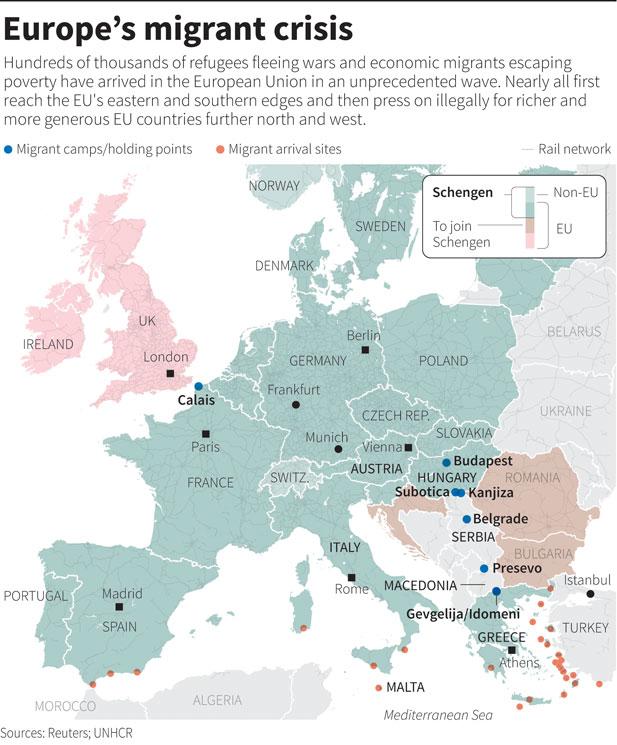Wars, climate shocks and economic turbulence are driving displacement to levels not seen in decades, thrusting refugee policy to the center of domestic politics and international diplomacy. From Europe’s border regimes to the Americas’ asylum systems and frontline hosting across Africa and Asia, governments are recalibrating in real time-tightening controls, brokering new deals and testing the limits of international protection.
The political fallout is reshaping coalitions, influencing elections and redrawing alliances. Populist parties are capitalizing on security and sovereignty narratives, centrists are split over deterrence versus protection, and budget pressures are widening North-South rifts over who pays and who hosts. As legal obligations collide with public opinion and capacity constraints, the refugee crisis is no longer just a humanitarian challenge; it is a defining force in the global balance of power.
Table of Contents
- Border Pressures Redraw Electoral Maps as Voters Shift Toward Security and Service Delivery
- Host Economies See Sector Specific Strains on Housing and Wages; Prioritize Rapid Work Permits, Credential Recognition and Direct Municipal Funding
- Fragmented Regional Coordination Fuels Smuggling and Instability; Adopt Shared Asylum Standards, Expand Humanitarian Corridors and Predictable Burden Sharing Mechanisms
- The Conclusion
Border Pressures Redraw Electoral Maps as Voters Shift Toward Security and Service Delivery
Intensifying cross-border movements are reshaping battlegrounds from coastal cities to inland suburbs, with swing precincts tilting toward contenders promising credible enforcement, faster public services, and budget discipline; party platforms are recalibrating to pair visible controls at checkpoints with pragmatic fixes in hospitals, classrooms, and housing, as municipal leaders warn of strained shelters and transit networks, and national campaigns test a new synthesis of order plus delivery that sidelines ideological grandstanding in favor of metrics, timelines, and oversight.
- Operational priorities: accelerated asylum adjudication, coordinated returns consistent with international law, and disruption of smuggling networks.
- Local capacity: expanded funding for shelters, clinics, and schools in high-arrival zones, with transparent reporting on service backlogs.
- Security-visible measures: technology at official crossings, targeted patrols, and cross-border intelligence sharing.
- Community stability: temporary work authorization pathways to reduce informal labor, paired with fair employer compliance checks.
- Accountability tools: independent audits, performance dashboards, and time-bound benchmarks for agencies handling reception and integration.
Host Economies See Sector Specific Strains on Housing and Wages; Prioritize Rapid Work Permits, Credential Recognition and Direct Municipal Funding
Across receiving countries, labor and housing markets are being reshaped unevenly: construction, logistics and hospitality report acute vacancies even as tenant demand pushes urban rents higher, while care work absorbs newcomers at low wages and professional sectors underutilize qualified arrivals stuck in licensing limbo. City treasuries face immediate service costs-shelter, transit, language access-without commensurate national transfers, and delayed work authorization fuels informal employment that undercuts tax bases and collective bargaining. Economists and mayors converge on a near-term playbook that treats time-to-work as the binding constraint, couples skills recognition with targeted upskilling, and routes funding directly to municipalities to expand housing and protect wage floors, mitigating political backlash while converting displacement into formal, taxed employment.
- Rapid work permits: adjudication within weeks, portable across employers, paired with basic labor-rights onboarding.
- Credential recognition: fast-track assessments and bridge programs for nurses, teachers, engineers and trades to relieve shortages above the low-wage tier.
- Direct municipal funding: flexible grants tied to new housing supply, wage monitoring, and local integration services to stabilize neighborhoods and small businesses.
Fragmented Regional Coordination Fuels Smuggling and Instability; Adopt Shared Asylum Standards, Expand Humanitarian Corridors and Predictable Burden Sharing Mechanisms
Competing border policies and case handling timelines across neighboring states are creating seams that criminal networks exploit, amplifying violence along routes and destabilizing host communities; policy officials and aid groups now coalesce around a three‑pillar response aimed at cutting smugglers’ margins, lowering deaths in transit, and distributing responsibilities more evenly across the region.
- Shared asylum standards: synchronize registration and screening timelines, enable mutual recognition of protection status, deploy interoperable case management with privacy safeguards, and enforce independent oversight to uphold non-refoulement and due process.
- Expanded humanitarian corridors: scale humanitarian visas, family reunification processing, medical evacuations, community sponsorship, and labor-study pathways, paired with joint search-and-rescue and predictable disembarkation arrangements.
- Predictable burden sharing: adopt a transparent allocation formula (e.g., GDP, population, reception capacity), allow flexible solidarity contributions (relocation or earmarked funding), and lock in multi-year financing to frontline municipalities and services.
The Conclusion
As borders harden in some places and corridors open in others, the refugee crisis is redrawing fault lines that run through cabinets, parliaments and polling booths. It is testing the resilience of international law, exposing gaps in burden-sharing, and reshaping agendas from trade to security.
What comes next will hinge on decisions made in the months ahead: election platforms that set the tone for national mandates, regional deals that reallocate responsibility, court rulings that define obligations, and funding pledges that determine capacity on the ground. For millions on the move-and the communities receiving them-these choices will set practical limits and possibilities.
Whether governments translate immediate political pressure into durable frameworks that balance protection with control will help determine the contours of global politics for years. The consequences will not stop at any border.


